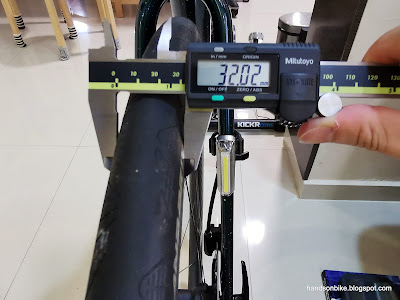In the previous post, I shared the new Ascent Bikes Zenith Elite carbon wheelset, which is my new 50 mm high profile carbon wheelset for fast road riding on the Cervelo Aspero. At the same time, I decided to change to a new set of tires as well, as the Continental GP4000 tires that came with the Reynolds Assault Limited Edition wheelset has about 3 years on it already.
Although the mileage is not high, I would like to get new tires, as they tend to lose their suppleness with age. We all know it is just an excuse to get new tires...
The latest generation of Continental road tires is the GP5000, which is an improved version of the very popular GP4000. Let's see what is the difference!
Continental GP5000 tires, also in the same 28 mm width as the previous GP4000 tires.
List of features that always includes better grip, better puncture resistance, lower rolling resistance, lower weight, etc.
Estimated tire circumference and maximum tire pressure for each tire width spec.
Weighs just 238 grams each! This is the clincher version, which would be lighter than the tubeless version.
In comparison, the old GP4000 tire in the same 28 mm width weighs more at 260 grams each.
Was there any magic formula that allowed the tire weight to be reduced from 260 to 238 grams? Short of making the tread or side walls any thinner, the tire can also be made to be narrower. Which is exactly what happened, even though both are rated as 28 mm wide tires.
GP5000 in front, GP4000 behind. Left side bead is aligned, but the GP4000 is wider by about 5 mm on the right side bead.
Although both are listed as 28 mm wide tires, they are from different generations, quite a few years apart. As such, they are designed based on different rim widths.
The old GP4000 was designed some years ago, when internal widths for road rims was still a conservative 15 mm wide. If the GP4000 28 mm tire was installed on a rim with internal width of 15 mm, the actual tire width should be close to the listed 28 mm. Therefore, when installed on wide modern rims, the tires become well over-sized.
Old GP4000 28 mm tires become 32 mm when mounted on the 21 mm internal rim width Reynolds wheelset. 4 mm oversized, which is also the stock condition from the Canyon Endurace.
The GP4000 tires bulge out from the rim visibly, as the actual tire width is 32 mm.
Another view showing the 32 mm tire width bulging from the rim.
New inner tubes to match the new GP5000 tires and new Zenith Elite wheelset. Which inner tube should I use?
The Continental inner tubes on the right are a bit wider (can't see from this view), and they came free with the pair of GP5000 tires.
Schwalbe SV15 with 60 mm valve weighs 110 grams.
Continental inner tube weighs more at 133 grams.
I decided to save some weight by using the lighter Schwalbe SV15 inner tubes. Let's see what is the actual width of the new GP5000 28 mm tires, when mounted on the Reynolds rim (21 mm internal) and also the new Zenith Elite rims (17 mm internal).
GP5000 28 mm tire on 21 mm internal rim width. Actual tire width is slightly over-sized at 28.5 mm.
GP5000 28 mm tire is about flush with the external rim width
GP5000 tire does not bulge out from the rim, unlike the GP4000 tire.
Both GP5000 tires installed on the new Zenith Elite rims!
Add a flash, and the Darklight reflective stickers make the rims stand out.
GP5000 tires on the Ascent Bikes Zenith Elite wheelset.
GP5000 28 mm tire on 17 mm internal rim width gives an actual tire width of 27.5 mm.
Using the new GP5000 tire on the old school rim width of 17 mm actually makes the tire undersized, which is uncommon nowadays.
Just for comparison, the new GP5000 tire + Zenith Elite wheel on the left, and the old GP4000 tire + Reynolds wheel on the right.
Due to the oversized GP4000 tire (in terms of width and also height), the tire diameter is also visibly larger.
The axle height comparison check also shows that the tire diameter of the GP4000 tire on Reynolds wheel is bigger.
50 mm rim profile on the left, with shorter tire height, and a 41 mm rim profile on the right, with a taller tire height.
Final comparison picture, with the GP5000 tire on the left, and GP4000 tire on the right. The width difference is 27.5 mm vs 32 mm, which is quite noticeable when positioned side by side.
What I learnt was that the old GP4000 tires will be oversized when mounted on anything wider than old school narrow rims of maybe 15-16 mm internal width.
On the other hand, the new GP5000 tires are designed to be matched with wider rims to get the true size. When mounted on old school 17 mm internal width rims, they are actually slightly undersized.
In summary, it is difficult to know exactly what tire width you are going to get, as the different tire designs and rim widths makes it quite unpredictable, until you actually mount it yourself.

















































